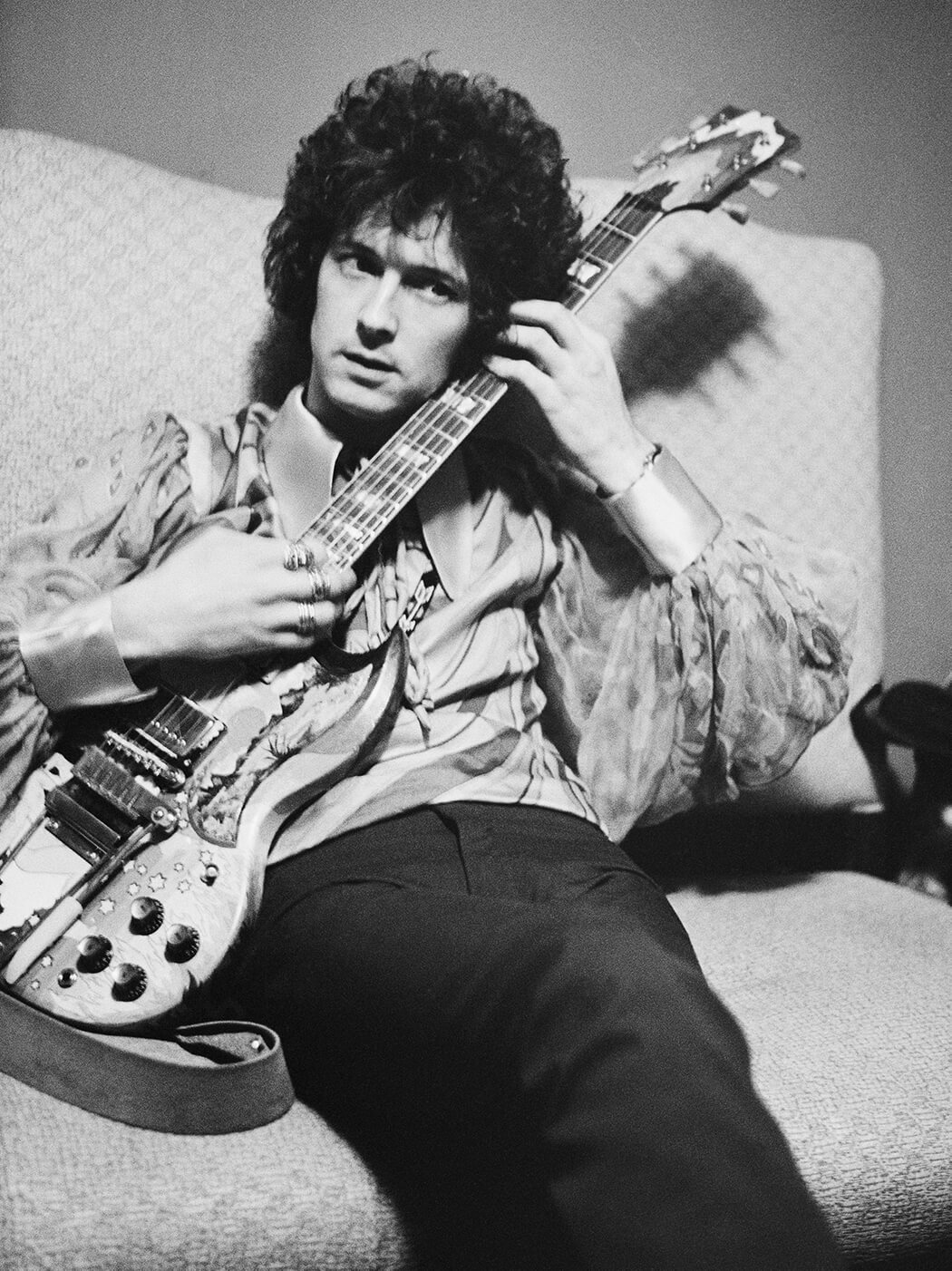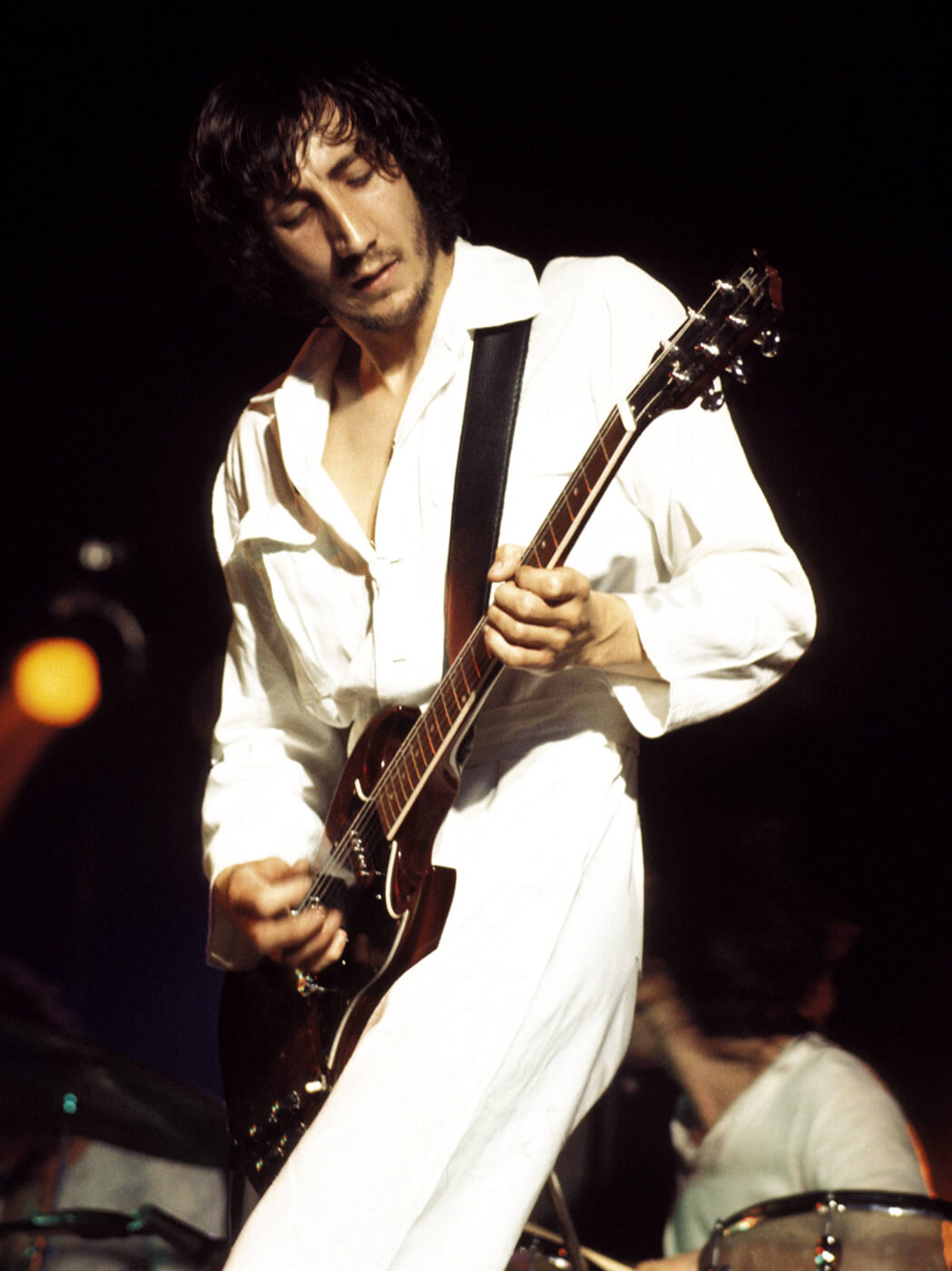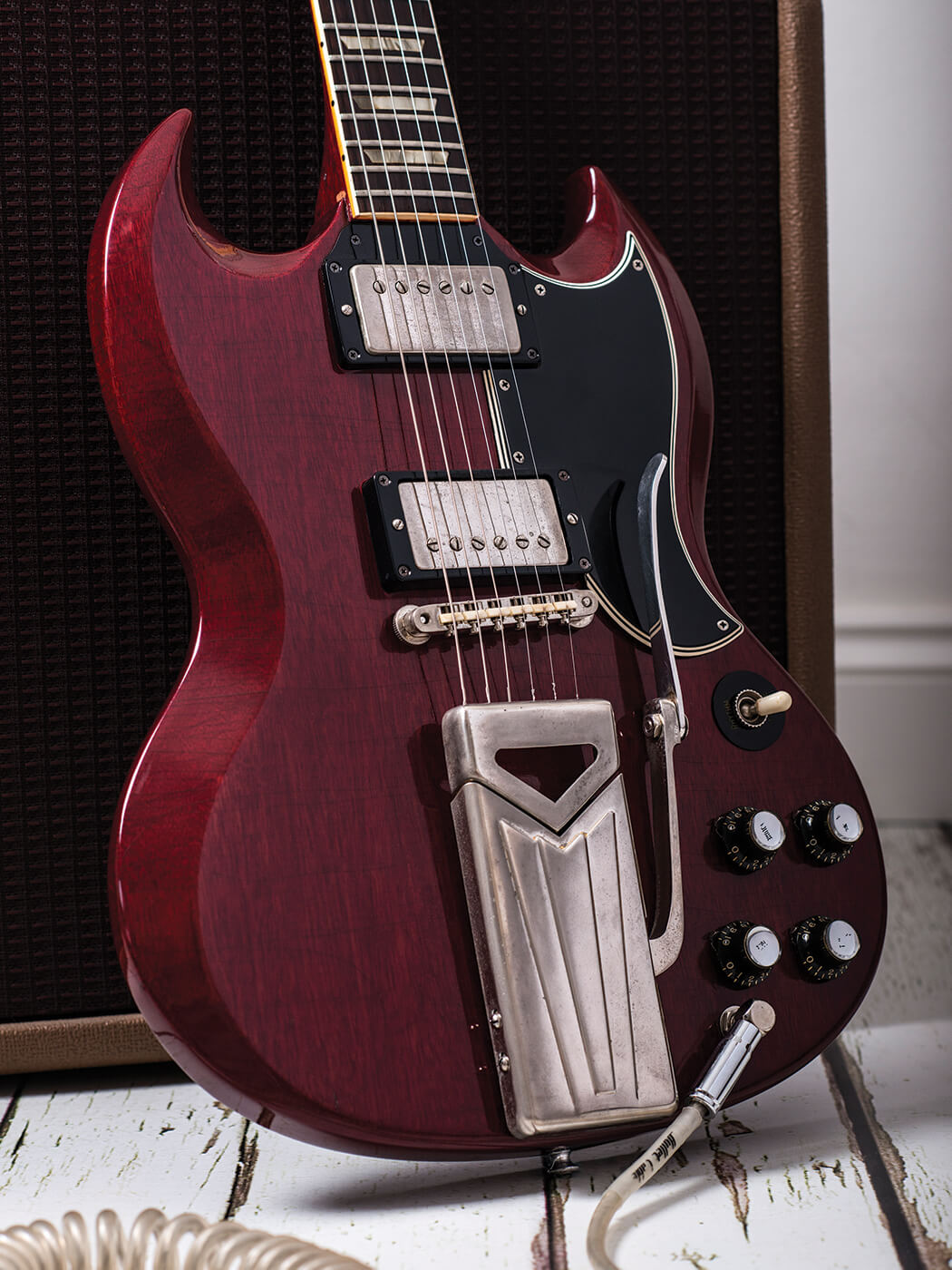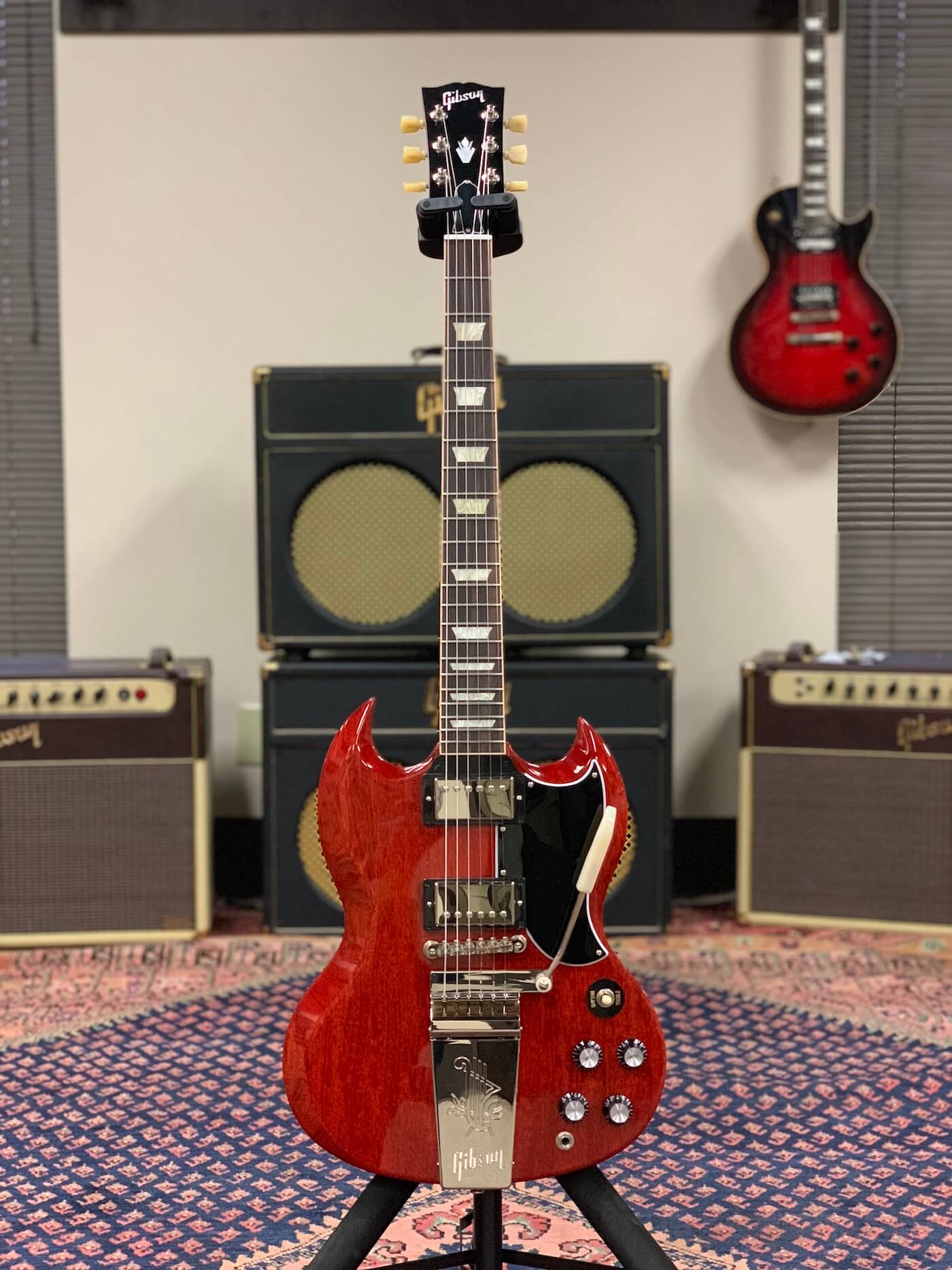Related Tags
The oral history of the Gibson SG
Although it didn’t find favour with the man himself, Gibson’s reboot of Les Paul’s signature model at the end of 1960 would go on to be the company’s best-selling model of all time. Here, we tell the story of the devil-horned solidbody that for many, is the ultimate rock guitar.

This is the oral history of the SG, the remarkable solidbody electric that Gibson introduced at the very end of 1960. Gibson intended the SG to be a replacement for the original Les Paul and at first, it too was called a Les Paul. Later confirmed as the SG, it was a radical departure in design, its body a modernistic mix of bevels and points and angles, offering excellent upper-fret access.

In the early 60s, Gibson expanded the SG line to include Standard, Custom, Junior, Special, and TV models, plus a few associated double-necks. They found favour with countless players through the years, including Eric Clapton, George Harrison, Sister Rosetta Tharpe, Pete Townshend, Angus Young, Frank Zappa and many more.
The voices here come from interviews conducted for my books about guitars. The people you’ll hear from are: Tony Iommi, guitarist with Black Sabbath (1968–2017); Johnny Marr, guitarist with The Smiths (1982–’87); Ted McCarty, president at Gibson (1950–’66); Tony McPhee, guitarist with The Groundhogs (1963–2015); Barry ‘The Fish’ Melton, guitarist with Country Joe & The Fish (1965–’70); Jimmy Page, guitarist with Led Zeppelin (1968–’80); Les Paul, guitarist (died 2009); and Derek Trucks, guitarist with The Allman Brothers Band (1999-2014) and the Tedeschi Trucks Band (2010–present).

Origin story
Ted McCarty
“Probably eight years after we got started with the Les Paul guitars, must have been the early 60s, Les and Mary Ford started to get a divorce. It became a very nasty, personal divorce. The disc jockeys throughout the entire United States refused to play any of his music. Now, all of a sudden what had been a very popular name and very strong for the sale of the guitars, well… now it was a detriment. And this bothered us, of course.
“When we’d first brought out the Les Paul in ’52 and Les started to use it, he was very valuable in those days – he was on television, he was playing in Vegas, very much in the public eye, him and Mary and it was a fine thing as far as we were concerned. Les and I became personal friends.
“But I was a little upset with Les, of course, when they did this sort of thing, the divorce. We kind of drifted apart for a little while. And he got really down as far as popularity. It was the worst thing that ever happened to him in his life, I guess.

“So we didn’t want the contract any more – which was a mutual affair – and eventually we dropped his name on the guitars. After he got his financial problems and the problems with his wife worked out, we paid him.
“In the meantime, we had the Les Paul Custom, the Les Paul Junior, we had about four or five models. These instruments, each and every one of them, carried this one-dollar royalty for him – and we were making thousands of them. So we continued to make the guitars and we just called them SGs instead of Les Pauls. We called them SGs, meaning Solid Guitar.”
Les Paul
“The contract with Gibson read this way: any instrument made by Gibson that had a pickup on it, whether it’s a banjo, no matter what it is, I was to receive my royalty. Yes sir, every instrument made by Gibson, period – a great contract. Now, not only that, they were to send me six of every model. So many came out that I never took the six, I says there’s no room for them, just send me one – and sometimes I didn’t even take one.
“And then came the divorce with Mary Ford and I. The contract came due in, I think, 1962, right at the time that Mary and I decided to split. Now, Gibson called me and said look, you don’t want to sign no contract in the middle of a divorce, we’ll wait till the divorce is over, and then we’ll re-sign. I agreed as much as they did.

“They were very cooperative with me. Both sides agreed that we would wait until the divorce was over—this had nothing to do with Mary, this was a separate item. We didn’t want to sign while that was going on, because her lawyers would ask for part of it in the divorce settlement. If it’s over, she’s not going to take part of something I no longer am with. So my contract ended in ’62, and Gibson could not make any more Les Paul guitars.
“So the SG was a guitar that was made with my name on it and when they sent me the prototype, I said, ‘I want you to reinforce the neck of it.’ Because you could bend it like a bow and arrow. It was bad. So tighten up on that neck and then you can have my name on it. This was before the divorce, going back to 1960. So they reinforced the neck, and I said, ‘Okay, you can put it out.’ Next one I got was bad again, and I said, ‘Hey, take my name off that guitar until you get it right.’
“The divorce came up: you can no longer make a Les Paul guitar, but they could make the SG. So that’s how the SG continued to exist, so that we can get a Les Paul guitar but it won’t have the name Les Paul on it. Reason being, I was not happy with that guitar, I didn’t like the horns, the cutaway – too sharp. Go up fast, you could injure your wrist. I said this guitar should have been okayed by me, and it wasn’t. That stayed in till the divorce and the divorce dragged on for several years.”

Gibson flyer, February 1961
“Here’s an established favorite, the Les Paul Standard model – now offered with completely new styling… thinner, lighter in weight and custom contoured. A wonderfully designed solid body, perfectly balanced for playing in a standing position. In fact, no matter how you hold your guitar, you’ll be comfortable playing the new Les Paul Standard. Beautiful cherry-red finish. Gibson Vibrola and an extra slim, fast, extremely low-action neck make this guitar a joy to play.
“Clear bell-like tone throughout its entire range. Exciting, modern design. Adjustable Tune-o-matic bridge. Twin powerful humbucking pickups with separate tone and volume controls that can be pre-set. Nickel plated metal parts and individual machine heads with deluxe buttons. Deluxe padded leather strap included. Les Paul Standard, Cherry finish, $265.00; Faultless plush-lined case $45.00.”
Modded for blues
Tony McPhee
“I got my SG Standard from the Selmer shop in Charing Cross Road, central London, in 1962. I chose it because it had a tremolo arm like a Stratocaster, which was my first choice – Hank Marvin had a Strat and I loved the single-coil sound of its pickups.
“I also loved the sound of Gretsch guitars and the look of their Jet Firebird. But the SG had the side-action vibrato – I hate the term whammy bar. And the clincher was the position of the pickup selector switch, similar to a Strat’s – but not a Goldtop’s, which was in the wrong place, ergonomically, as far as I was concerned. And the Goldtop was a heavy guitar.

“I made some changes to my SG through the years. I took off the vibrato cover – I thought of the vibrato like a side-to-side-action Morse-code key, like ultra-fast Morse-code operators used and it didn’t cause me any problems. I put a capacitor on the volume pots between the slider and output tags, which enhanced the treble. I called it the tone changer and you can hear it on Mistreated on the Blues Obituary album.
“Also, I put a push-button switch mid-body that put a capacitor across the output, like a tone control – my version of a wah-wah pedal, before I got my first Schaller wah. I’d press it in solos and so on to imitate a wah pedal. Later, I had Paul Raven, the Killing Joke bassist, make a TS logo for the pickguard and at one time, I put a Strat pickup between the two humbuckers.
“Anyway, in 1986 that original SG Standard [serial number 54146] was stolen from a dressing room at a gig in a theatre in Irvine, Scotland. The buggers! Later, around 2006, I bought an SG Special. It had a great action, but I found the neck was too narrow, and Derek Forbes, ex-Simple Minds, has it now. My career is on hold these days after the stroke I suffered in June 2009, which stole my voice and a certain amount of dexterity.”
Access and reach
Barry ‘The Fish’ Melton
“Country Joe & The Fish were rehearsing in a little nightclub in Berkeley called the Jabberwock, where we met a family who fell in love with the band. They wanted to buy us all instruments and help the band get started. It turned out that their son had been killed in an automobile accident about a year before, and adopting the band was some way of memorialising their son.
“When they asked me what I would buy if I had the money to buy the guitar I wanted, I chose my first SG, which I think I got at Leo’s in downtown Oakland. It wasn’t long after I bought my Standard that I had a Bigsby bar attached to it. I wanted that Bigsby bar because, after all, we were making The New Music.

“The SG has almost two full octaves on the fretboard and you can reach the higher octaves. In fact, I could bend the very last note on the high E string to get to the high E. You could reach it all on the SG. But I don’t think I ever really got in tune until the 70s.
“My original SG Standard was stolen back in 1971 and I immediately bought another to replace it. That’s the one I’ve been playing ever since. That’s the one you’ll see me with, if I can do anything about it. I have spares and it’s had at least two neck repairs, up near the head. The neck on the SG is fragile. My guitar-repair guy assures me that the neck is actually stronger in the places where it’s been glued than it is in other places.”
Old boy is no Gibson
Tony Iommi
“I first started using an SG Special on the first Black Sabbath album. I always used to play Fenders and was using a white Strat. I bought the SG as a backup, a second guitar, and I’d never really played it. I hadn’t had it that long. We were in the studio doing the album and the pickup went on the Strat. Typical, isn’t it? And we only had a day to record the album. So I didn’t have a lot of time, and I used the Gibson. And that was it, really. I never sort of went back.
“The first one I had was a right-handed one and I was going to use it upside down. But somebody contacted me, said they’d got a left-handed one, so I met them at some service station or something, and we swapped guitars. That was it: now I had a left-handed one and he had a right-hand one.

“For me, the SG is lighter. I did want a Les Paul, a bit later, probably once we got rolling. I liked the Les Paul, but I could never find a left-handed one in them days. And I’ve never felt right and comfortable with a Les Paul, it’s just too heavy for me and reaching the top frets is harder. The SG, I could reach the top frets – and since I took the end of my fingers off in an accident, that was a bit difficult with a lot of guitars. I like that it’s a small body, as well. It’s comfortable.
“One of those crazy ideas at the time, I wanted a 24-fret guitar. There were none about. I just thought, ‘Oh, that would be good for me.’ I used to experiment a lot and wanted to do things, and of course I couldn’t actually do them myself. I approached a couple of companies and they weren’t interested, they said: ‘Oh no, nobody�’s gonna use that.’ Around 1970, I met John Birch and I teamed up with him. I actually put money in to run the company and he made me a 24-fret SG, so then I used that.
“John Diggins came to work for John Birch and I took him on the road with me. He used to set my guitars up and stuff. He worked for John for a bit and then he made a guitar for me at home – on his kitchen table. That was my first one from John Diggins.
“The original Old Boy was my old red SG and then John Diggins made me the Old Boy, probably around ’75, this guitar he made at home, SG-style, 24 frets, cross inlays. That’s the one I always used, for many years. I really like that guitar, though I don’t really take it on the road now, it’s too valuable. I’ve had a good many years out of that one, and it really is one of my favourite guitars.”
Six and twelve
Jimmy Page
“I got a Gibson double-neck [EDS-1275] to fit in with Stairway To Heaven, because there were so many guitar parts. There’s acoustic, and 12-string and the solo and I thought I can’t do this on only one of those guitars. But I’d seen double-necks before. I’d seen them in country music – Grady Martin, Joe Maphis – and I’d seen one in Family. You remember Family? That guy had a double-neck.

“So anyway, I asked to get one from Gibson, because I knew it was the only way, I knew I couldn’t do Stairway live… but it was essential to do it. So it became iconic, didn’t it? And a little tough on the left shoulder, yeah, though I’ve got heavier guitars. But nevertheless, it was pretty weighty.”
Johnny Marr
“A lot of my musical education came from pop records of the early 70s onwards, because that’s when I started buying records. Whether they were T.Rex or Cockney Rebel, Sweet, Sparks, they were a synthesiser-free zone, but still quite elaborate. It may be my personal nostalgia, but that was my golden era, from glam rock onwards. Luckily, those records were adorned with lots of multi-layered guitars.
“Much as I was into T.Rex, you’d hear things like Magic by Pilot and I remember when they were on Top Of The Pops, the guitarist played a double-neck SG [Ian Bairnson on EDS-1275]. I was 10 or 11 and I was fascinated to know what that other neck was doing. He looked immediately twice as proficient as anyone else who’d just been on.
“So it was seeing double-necks that gave me a curiosity about 12-strings – it was a visual cue. I was soaking up information on that pop culture. And I found out that those double-necks sound incredible, because you have all of that body mass. A giant table-top!”
One brother to another
Derek Trucks
“When I was kid, I had this photo hanging in my room of Duane Allman with an SG. I was taken with the sound of his instrument, but there was something about the look of that guitar. I think your first hero, seeing that instrument – well, that was the guitar that I wanted as a kid.
“When I first started playing, I’d ask around. A lot of guys I played with had Les Pauls, it was all Les Pauls and Stratocasters, maybe a Tele – you didn’t see a lot of SGs. So I think that made it even a little bit more exotic.
“And then, had to be ’91, ’92, something like that, after a few years of playing, I think my parents saved up, and they took me to this music store in downtown Jacksonville, Paulus Music. They pulled out this brand new Gibson case. I even remember the smell of the lacquer in the inside of the case. That first new-guitar smell! I think it was a ’62 reissue SG Standard.

“From that moment on, the SG was the guitar I always played or always come back to. I’ve gone through trying to play other instruments, convincing myself that I really like them and then I always fall back to the SG. Even though the SG is kind of an aggressive-looking guitar, there’s still, for me, something classic about it.
“And I like the weight of it. I like the way it sings. It almost feels like a hybrid between a Strat and a Les Paul, but it still has that bite. I don’t play with a pick often, it’s usually just my hands, so there’s something about the bark of an SG that I really love.
“I still have that first one. I played it for 10, 15 years. That’s the one I’ve got a boatload of signatures on. I remember we were playing some club, I think Aspen, Colorado, just rowdy clubs that we played all the time… and you leave your guitar on the stand between sets. I remember going back for the second set and picking it up and feeling the strings just loose, and then looking at the headstock. I think somebody had just knocked it off the stand and put it back up. I had it repaired and it was fine, but it was never quite the same. So I ended up moving on to another one at that point and just stashing that thing away.
“And then Galadrielle Allman, Duane Allman’s daughter, gave me one of the Dickey Betts ‘One Brother To Another’ Gibsons, that recreation of the SG that Dickey had given to Duane. They took that guitar and copied it and relic’d it out. So she sent me one of those, an artist proof from that run, and it was the lightest SG I’d ever felt. That one immediately became my everyday guitar. And later still, I did my signature SG with Gibson.
“Now, a Strat seems kind of bulletproof. You can run over it with a car and it’ll probably still play just fine. But an SG seems a little more hands-on. You have to really be on it. I like that. I like the ever-changing elements of it.”
Also learn about the history of the Les Paul and ES-335.
